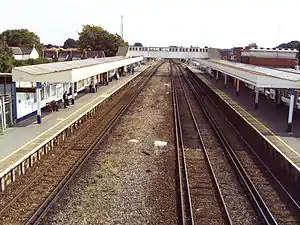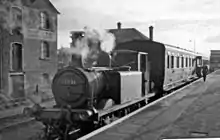Havant railway station
Havant railway station is a railway station in Havant, Hampshire, near Portsmouth, located on the Portsmouth Direct Line which runs between London Waterloo and Portsmouth Harbour. Havant is served by trains operated by South Western Railway, Southern and Great Western Railway.
 Havant railway station as seen from the western footbridge | |
| Location | Havant, Havant England |
| Grid reference | SU717065 |
| Managed by | South Western Railway |
| Platforms | 2 |
| Other information | |
| Station code | HAV |
| Classification | DfT category C2 |
| Key dates | |
| 15 March 1847 | opened |
| 1863 | resited |
| Passengers | |
| 2015/16 | |
| 2016/17 | |
| 2017/18 | |
| Interchange | |
| 2018/19 | |
| Interchange | |
| 2019/20 | |
| Interchange | |
| Notes | |
Passenger statistics from the Office of Rail and Road | |
Railways in the Portsmouth area |
|---|
| Hayling Island Branch Line | ||||||||||||||||||||||||||||||||||||||||||||||||||||||||||||||||
|---|---|---|---|---|---|---|---|---|---|---|---|---|---|---|---|---|---|---|---|---|---|---|---|---|---|---|---|---|---|---|---|---|---|---|---|---|---|---|---|---|---|---|---|---|---|---|---|---|---|---|---|---|---|---|---|---|---|---|---|---|---|---|---|---|
| ||||||||||||||||||||||||||||||||||||||||||||||||||||||||||||||||

Havant is the nearest station to Hayling Island and also serves the nearby town of Waterlooville. Buses depart from the nearby bus station to both these places. [1]
History
The first station at Havant was built in 1847 by the London, Brighton and South Coast Railway (LBSCR) 500 m to the east - a small wayside station (called Havant Halt). It was demolished after a serious fire. A newer station was then built 200 m west to serve the then new London and South Western Railway (LSWR) Portsmouth Direct Line. This station was demolished so that a bigger station could be built 300 m further west to serve the new Hayling Island branch line.[2] It had three platforms, one for Hayling Island[3] and two for the stopping main line services.
Prior to grouping, the "Battle of Havant" took place between the LB&SCR and the L&SWR when the two railway companies fought for the right to use LB&SCR tracks into Havant in order for the L&SWR to reach Portsmouth (see Havant New). Although a rarity in the UK, these disputes were quite common in the United States where they were known as frog wars.
Havant was the terminus for the Hayling Island branch services until late in 1963. Apart from the platform there was a run round loop, a siding serving a warehouse and a water column supplied by a circular metal water tank located near the signal box. In the Spring of 1966 the Hayling Island tracks were removed. The space they occupied was later replaced with a car park and a fence on the south side of the platform.[4]
As part of the Waterloo to Portsmouth electrification the station was completely rebuilt in 1938. The number of tracks was increased from two to four, two for stopping trains and the two for non-stop, generally express trains. The northernmost of the two fast tracks (as mentioned above) was later removed, and the remaining fast (through) track was also removed in late 2006. Judging by the new track layout east of the station, this arrangement seems to be permanent.
After the engineering work of 2007 was finally completed after a lengthy delay that had lasted from the beginning of the year, the stations two platforms have become bi-directional platforms. This means that both platforms can be used for trains going in either direction. Such as when the fast Waterloo service, the xx34 is running late behind the slow Waterloo service xx40. This means that the Slower service may be placed on Platform 1, which services to London go on, and wait, while the faster service is brought onto Platform 2, and then over take the service, so that it can make up the time lost, and not lose more time while waiting to overtake the slower service up in Haslemere station.
Recent changes

Since July 2006, the Hayling Island platform face no longer exists and a new cycle centre has been built in place of the former platform. A new station name pole has been erected at the position also. As well as these, most of the signs within the station have also been changed and new seats have been installed on the platforms. This is in line with commitments made in the current South West Trains franchise. The signs are in the more traditional style (as seen at Clapham Junction, Wimbledon and across the Southern Railway network).
There has been some discussion about putting a third (terminating) platform in the gap, however this would have to be very short and narrow. There has also been discussion about reinstating the Hayling Island platform, and even the whole Hayling Island branch. Both of these proposals have now been completely abandoned.[5]
In December 2006, the fast southbound through track was removed. Both the entry and exit from the southbound platform were straightened out to allow a quicker entry and exit speed. New crossovers were put in place to allow bi-directional working on both platforms. From west to east the new layout will be: new NB->SB crossover, new SB->NB crossover, existing road bridge, platforms, new NB->SB crossover, existing SB->NB crossover, level crossing. The level crossing was also resurfaced and new crossing gates installed
Services
Havant is a junction station and provides passengers with an interchange between the West Coastway line and the Portsmouth Direct Line. It therefore has services to Portsmouth, London Waterloo, London Victoria via Gatwick Airport, Brighton, Southampton and less frequent long-distance services to Wales and the west country. As of 9 December 2007, South West Trains no longer serve the Brighton Line with the dominant train operator on this route, Southern, reworking its Coastway timetable to accommodate the move. A service is also provided by Great Western Railway to and from Great Malvern.
The typical off-peak service is as follows:
Eastbound
- 3tph to London Waterloo
- 2tph to Brighton
- 2tph to London Victoria
- 1tph to Littlehampton
Westbound
- 3tph to Portsmouth Harbour
- 3tph to Portsmouth & Southsea
- 2tph to Southampton Central
- 1tpd to Bristol Temple Meads
- 1tpd to Great Malvern
| Preceding station | Following station | |||
|---|---|---|---|---|
| Rowlands Castle | South Western Railway Portsmouth Direct Line (stopping services) |
Bedhampton or Terminus | ||
| Petersfield | South Western Railway Portsmouth Direct Line |
Fratton | ||
| Chichester | Great Western Railway West Coastway Line |
Cosham | ||
| Emsworth | Southern Southampton to Brighton and Southampton to London Victoria |
Cosham | ||
| Chichester | Southern Portsmouth to London Victoria |
Fratton | ||
| Emsworth | Southern Portsmouth to Brighton |
Fratton | ||
| Warblington | Southern Portsmouth to Littlehampton |
Bedhampton | ||
| Disused railways | ||||
| Terminus | Southern Region of British Railways Hayling Island branch line |
Langston | ||
Further reading
- Cousins, Frank; rogers, Rogers (October 2017). A Brief History of the Railway in Havant & The Arrival of the Railway in Emsworth (PDF). Havant History Booklet. 3. Waterlooville: HSDC. Archived (PDF) from the original on 10 January 2021. Retrieved 10 January 2020.
References
- https://tiscon-maps-stagecoachbus.s3.amazonaws.com/ZoneMaps/South/HavantAreaMapSep19.pdf
- Memories of the Hayling Island Branch:Produced by Ian Heys for "Branch Line Videos", Catalogue Number 418-514424
- "Branch Line to Hayling" Mitchell,V./Smith,K (In association with Bell,A): Midhurst, Middleton Press, 18984 ISBN 978-0-906520-12-3.
- "Catching the train to Hayling Island: a history" Newell, L: Havant, Havant Borough Council, 2005.
- Re-open Havant/Hayling Island Railway Line, 23 February 2006
External links
| Wikimedia Commons has media related to Havant railway station. |
- Train times and station information for Havant railway station from National Rail